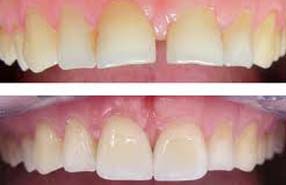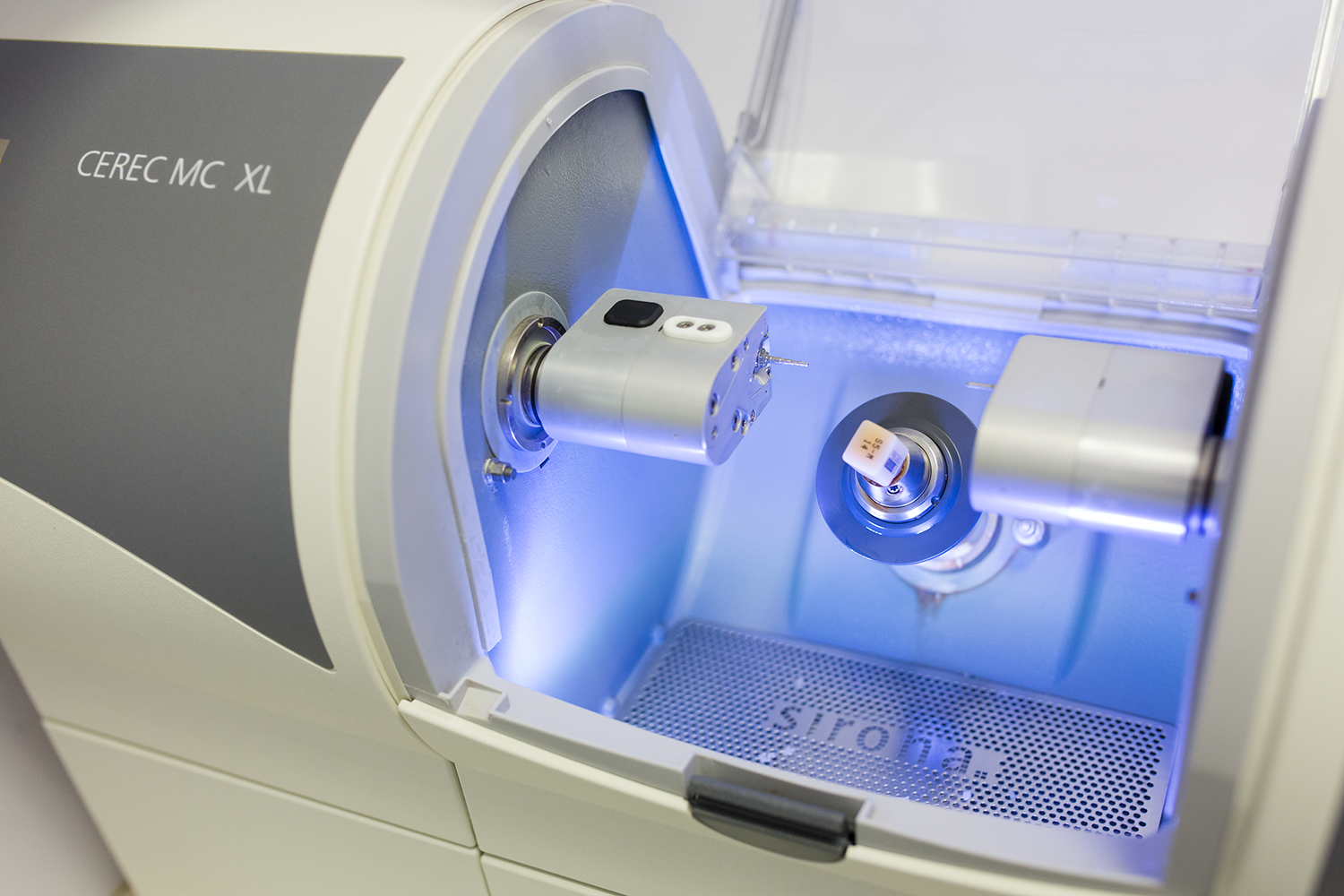
Cleanings
Teeth cleaning (also known as a prophylaxis, literally a preventative treatment of disease) is a procedure for the removal of tartar (mineralized plaque and/or calculus) that may develop even with careful brushing and flossing.
This can happen especially in areas that are difficult to reach during routine homecare. Professional cleaning includes removing foreign deposits from the teeth and tooth polishing.
If a large amount of tartar has accumulated, we have various instruments and techniques we can use to remove these deposits from the teeth in a comfortable manner.
We recommend having the teeth professionally cleaned every six months. More frequent cleaning and examination may be necessary when treating periodontal (gum disease) and other conditions. Routine examination of the teeth is recommended at least every year.
Regular prophylaxis by one of our four dental hygienists coupled with good oral hygiene helps to prevent cavities, tartar build-up, gum disease and benefits your overall health.

Fillings
Thanks to advances in modern dental materials and techniques, dentists have more ways to create pleasing, natural-looking smiles.
Dental researchers are continuing their often decades-long work developing materials, such as ceramics and polymer compounds that look more like natural teeth. As a result, dentists and patients today have several choices when it comes to selecting materials to repair missing, worn, damaged or decayed teeth.
These new materials have not eliminated the usefulness of more traditional dental materials, such as gold, base metal alloys and dental amalgam.
That’s because the strength and durability of traditional dental materials continue to make them useful for situations, such as fillings in the back teeth where chewing forces are greatest.

Whitening / Bleaching
Tooth whitening ( bleaching) brightens teeth that are discolored or stained. Bleaching may be done completely in the dental office or the dentist may dispense a system for you to use at home.

Cosmetic
A smile can be the most eye-catching feature of a face. With dentistry's many advances, you no longer have to settle for stained, chipped, or misshapen teeth. You now have choices that can help you smile with confidence.
Even the most subtle change in your smile can make a dramatic difference in the way you look and feel about yourself. Talk to your dentist about the options most suitable for you, what your expectations are and the dental fees involved.
Enamel shaping involves modifying teeth to improve their appearance by removing or contouring enamel. The process, which often is combined with bonding, usually is quick and comfortable and the results can be seen immediately.
Veneers are thin custom-made shells designed to cover the front side of teeth. Made of tooth-colored materials, veneers are used to treat spaces between teeth and teeth that are chipped or worn, permanently stained, poorly shaped or slightly crooked.
Braces are not just for kids. Orthodontics may be needed if teeth are crooked, crowded or do not meet properly. If your dentist thinks you should see a specialist for treatment, he or she will refer you to an orthodontist.

Bonding
Bonding can improve the appearance of teeth that are chipped, broken, cracked, stained, or have spaces between them. With bonding, tooth-colored materials are applied, or bonded, to the tooth surface.

Cerec
We are pleased to offer our patients CEREC® restoration services-a superior method of creating precisely-designed, color-matched and highly durable ceramic restorations right in our practice. From simple fillings to full crowns, CEREC® delivers the results you need in a single appointment.
After examining the tooth and determining the course of treatment, we will prepare your tooth for restoration, similarly to traditional treatment methods. Your prepared tooth will be coated with a safe, tasteless powder.
CEREC® then uses a state-of-the-art digital 3D camera to create an optical impression. This digital image replaces the physical impression required in traditional procedures. No more long waits while a tray of impression goop
hardens in your mouth.
State-of-the-art CAD software allows us to design every precise detail of your restoration with the accuracy you've come to expect from us. The software allows us to customize the shape of the restoration to exactly fit
your specific clinical needs.
While you wait, exact design specifications are sent to our on-site milling machine to create your restoration. About 10 minutes later, your all-ceramic, color-matched restoration is ready for placement. Your new restoration is then fitted, polished and bonded for permanence. Your tooth is restored back to its natural form, function and beauty.

Crowns
If you want a smile that's your crowning glory, you may need a crown to cover a tooth and restore it to its normal shape and size. A crown can make your tooth stronger and improve its appearance. It can cover and support a tooth with a large filling when there isn't enough tooth left.
It can be used to attach a bridge, protect a weak tooth from breaking or restore one that's already broken. A crown is a good way to cover teeth that are discolored or badly shaped. It's also used to cover a dental implant.
If your dentist recommends a crown, it's probably to correct one of these conditions. Your dentist's primary concern, like yours, is helping you keep your teeth healthy and your smile bright -- literally, your crowning glory.

Bridges
If you're missing one or more teeth, you may notice a difference in chewing and speaking. There are options to help restore your smile. Bridges help maintain the shape of your face, as well as alleviating the stress in your bite by replacing missing teeth.
Sometimes called a fixed partial denture, a bridge replaces missing teeth with artificial teeth, looks great, and literally bridges the gap where one or more teeth may have been. The restoration can be made from gold, alloys, porcelain or a combination of these materials and is bonded onto surrounding teeth for support.
Unlike a removable bridge, which you can take out and clean, a fixed bridge can only be removed by a dentist. An implant bridge attaches artificial teeth directly to the jaw or under the gum tissue.
Depending on which type of bridge your dentist recommends, its success depends on its foundation. So it's very important to keep your remaining teeth healthy and strong.

Extractions
What should you expect when you are scheduled for a tooth extraction? Your dentist will numb the area to lessen any discomfort. After the extraction, your dentist will advise you of what post extraction regimen to follow, in most cases a small amount of bleeding is normal.
Avoid anything that might prevent normal healing. It is usually best not to smoke or rinse your mouth vigorously, or drink through a straw for 24 hours. These activities could dislodge the clot and delay healing. For the first few days, if you must rinse, rinse your mouth gently afterward, for pain or swelling, apply a cold cloth or an ice bag. Ask your dentist about pain medication.
You can brush and floss the other teeth as usual. But don't clean the teeth next to the tooth socket. When having an extraction, today's modern procedures and follow up care as recommended by your dentist are there to provide you the patient great benefit and comfort.

Dentures
If you've lost all of your natural teeth, whether from periodontal disease, tooth decay or injury, complete dentures can replace your missing teeth and your smile. Replacing missing teeth will benefit your appearance and your health. Without support from the denture, facial muscles sag, making a person look older. You.ll be able to eat and speak. things that people often take for granted until their natural teeth are lost.
There are various types of complete dentures. A conventional full denture is made and placed in the patients mouth after the remaining teeth are removed and tissues have healed which may take several months. An immediate complete denture is inserted as soon as the remaining teeth are removed.
The dentist takes measurements and makes models of the patients jaws during a preliminary visit. With immediate dentures, the denture wearer does not have to be without teeth during the healing period.
Even if you wear full dentures, you still must take good care of your mouth. Brush your gums, tongue and palate every morning with a soft-bristled brush before you insert your dentures to stimulate circulation in your tissues and help remove plaque. Removable partial dentures usually consist of replacement teeth attached to pink or gum-colored plastic bases, which are connected by metal framework.

Implant
Crowns and conventional bridges or dentures may not be your only options when replacing missing teeth. For some people, dental implants offer a smile that looks and feels very natural.
Surgically placed below the gums over a series of appointments, implants fuse to the jawbone and serve as a base for individual replacement teeth, bridges or a denture. Implants offer stability because they fuse to your bone.
Integration of the implants into your jaw also helps your replacement teeth feel more natural and some people also find the secure fit more comfortable than conventional substitutes.
Candidates for dental implants need to have healthy gums and adequate bone to support the implant. A thorough evaluation by your dentist will help determine whether you are a good candidate for dental implants.

Root Canals
Once upon a time, if you had a tooth with a diseased nerve, you'd probably lose that tooth. Today, with a special dental procedure called a root canal therapy you may save that tooth.
Inside each tooth is the pulp which provides nutrients and nerves to the tooth, it runs like a thread down through the root.
When the pulp is diseased or injured, the pulp tissue dies. If you don't remove it, your tooth gets infected and you could lose it. After the dentist removes the pulp, the root canal is cleaned and sealed off to protect it. Then your dentist places a crown over the tooth to help make it stronger.
Most of the time, a root canal is a relatively simple procedure with little or no discomfort involving one to three visits. Best of all, it can save your tooth and your smile!

Veneers
There's no reason to put up with gaps in your teeth or with teeth that are stained, badly shaped or crooked. Today a veneer placed on top of your teeth can correct nature's mistake or the results of an injury and help you have a beautiful smile.
Veneers are thin, custom-made shells crafted of tooth-colored materials designed to cover the front side of teeth. They're made by a dental technician, usually in a dental lab, working from a model provided by your dentist.
You should know that this is usually an irreversible process, because it's necessary to remove a small amount of enamel from your teeth to accommodate the shell.
Your dentist may recommend that you avoid some foods and beverages that may stain or discolor your veneers such as coffee, tea or red wine. Sometimes a veneer might chip or fracture. But for many people the results are more than worth it. If you have any questions about veneers ask your dentist.

















